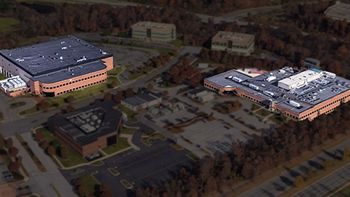
- Pharmaceutical Commerce - May/June 2017
US drug 2016 sales, at $450 billion, moderate to single-digit growth
Latest QuintilesIMS report sees 5.8% growth in 2016; more emphasis on ‘net-price’ spending
Total US spending on medicines; growth rates[/caption]
The Use of Medicines report from QuintilesIMS has traditionally provided a reliable measure of trends in drug spending across the spectrum, both in terms of therapy categories as well as distribution channels such as retail vs. hospital. The newly published report for 2016 finds that the double-digit growth of the past two years (it was 12.2% in the previous year) has moderated to 5.8%, or $450 billion. In recent years, QuintilesIMS has refined its analysis of ex-manufacturer pricing (now called “invoice-price spending, or the nominal price with which drugs go to market, versus the “net price” spending, a measure of the revenue actually received by manufacturers after various discounts are factored in). On a net-price basis, QuintilesIMS estimates US industry revenue at $323 billion, up 4.8% from the previous year, and a growth rate almost half of the 8.9% increase in 2015.
Last year, QuintilesIMS projected a 6-9% CAGR for medicines through 2020; now it is projecting a 4-7% CAGR range, with invoice price spending reaching $580-610 billion by 2021. A factor in this growth slowdown is the “atypical” introduction of hepatitis C treatments, beginning in late 2014 and continuing; the number of patients treated jumped from less than 20,000 annually to almost 250,000 in the space of a year, and has since dropped to 226,000 annually. The high and unexpected jump in medical costs back then, which rattled the entire healthcare ecosystem, kicked off the current heightened focus on drug costs.
QuintilesIMS estimates that the growing number of drugs in the hep C category are both lowering the invoice price of drugs, as well as generating discounts of as much as 50% for existing products on the market. (Merk’s Zapatier treatment, approved in 2016, is reported to list-price at $56,400, well below the $80-90,000 of the first new treatments). And while some 645,000 patients now have a nominal cure of their disease (remission rates of more than 90% are typically seen), some 2-4 million more patients are yet to be treated. Re-infection rates are not yet known.
The discounting battle
The difference between manufacturers’ list prices, and the revenue they actually receive, is a bone of contention between the industry, its critics and its trading partners that rising in intensity. QuintilesIMS, using what it calls its “proprietary derived estimate” of discounting’s effects, projects a roughly 35% difference between the two. A few industry spokespeople (notably Heather Bresch, Mylan CEO) blames intermediaries like pharmacy benefit managers (PBMs) for driving price increases; as the drug price rises, so does the discount. PBMs and other point the finger the other way, blaming industry pricing practices for drugs’ higher costs.
QuintilesIMS data back up the industry stance, to a degree: on a per capita basis (which washes out changing patient populations, itself a driver of spending growth), real net spending growth has averaged 1.1% per year since 2006—from $805 per capita to $895 over the past 10 years. “Underlying these trends are complex and confidential negotiations between multiple stakeholders, setting price, rebate, and usage protocols intended to control the trend of overall medicine spend,” says the QuintilesIMS report. “As a result of the opaque system of pricing, it is difficult for many stakeholders to understand if they are achieving the same level of modest growth as seen for manufacturer’s net revenues.”
What has become clearer, however, is that patients are seeing a higher hit to their pocketbooks. While, according to QuintilesIMS, average out-of-pocket (OOP) costs across the board for patients have declined by $1.19 per 30-day prescription since 2013, patients with high-deductible insurance plans are seeing eye-watering OOP increases, especially in the deductible period of their policies (typically at the beginning of each year). Manufacturers have responded with more generous “OOP offsets” (primarily coupons); meanwhile, 19% of brand prescriptions, and 34% of specialty medications, have copays and coinsurance set according to the list price (rather than a discounted price paid by insurers) of the drugs. The end result of all this is that some patients, in some commercial insurance plans, pay very high prices at least for part of the year.
Biologics shine
The QuintilesIMS report measures net-price revenue for biologics at $103 billion in 2016, crossing the $100-billion milestone and up 13% from the previous year. Biologics’ introduction into commercial use is not without its disappointments: Repatha (evolocumab) and Praluent (alirocumab) cholesterol treatments based on monoclonal antibodies, introduced with much fanfare (and concern over their cost) last year, represented less than 0.001% of the market at the end of the year, as most prescribers stuck with the older statin drugs, which are now almost entirely off-patent.
Biotech companies are looking to the excitement around immuno-oncology drugs (see p. xx) as one element in future growth; rare disease treatments are also promising. The biggest cloud over biologics is the introduction of biosimilars; according to QuintilesIMS data, two biosimilar products now occupy 42% of the market for filgrastim, one of the older biologics. The pipeline for biosimilar introductions is growing, especially for those already commercialized in Europe and elsewhere, and where clinical outcomes data will help persuade prescribers.
Channel trends
Where patients fill their prescriptions affects what they pay; from a manufacturer perspective, ensuring that medicine is available at the dispensing point the patient prefers is an important commercialization factor. Continuing a years-long trend, retail chains are the leading channel in prescription fulfillment, representing 30.1% of the net-invoice revenue, and 55.9% of dispensed prescriptions (this figure does not include clinic- or hospital-dispensed drugs; also, it is adjusted to convert one 90-day prescription to three 30-day ones).
While the across-the-board net invoice revenue grew by 5.8% in 2016, retail chains almost matched that (growing 5.4%). Independent pharmacies fell off the pace; their growth was 4.0%; and their proportion of dispensed prescriptions was a couple percentage points below overall prescription growth. The big winner in net-price revenue was mail order, up 7.3%, while the big winner in prescription growth was food stores, up 7.3%, nearly double the overall growth in prescriptions.
The Report is available
Articles in this issue
over 8 years ago
The sales rep study I’d like to seeover 8 years ago
Survey tracks evolving health economics function in pharmaover 8 years ago
Is your corporate board equipped to monitor incentive programs?over 8 years ago
2017 Product Security Reportover 8 years ago
Compliance Package of the Year goes to Merck’s Zepatierover 8 years ago
How cloud-based IT systems address FDA validation requirementsover 8 years ago
Future look: The Impact of Biosimilars on Oncologyover 8 years ago
New science energizes the cancer marketover 8 years ago
A Conversation with John Chiminski, CatalentNewsletter
Stay ahead in the life sciences industry with Pharmaceutical Commerce, the latest news, trends, and strategies in drug distribution, commercialization, and market access.




